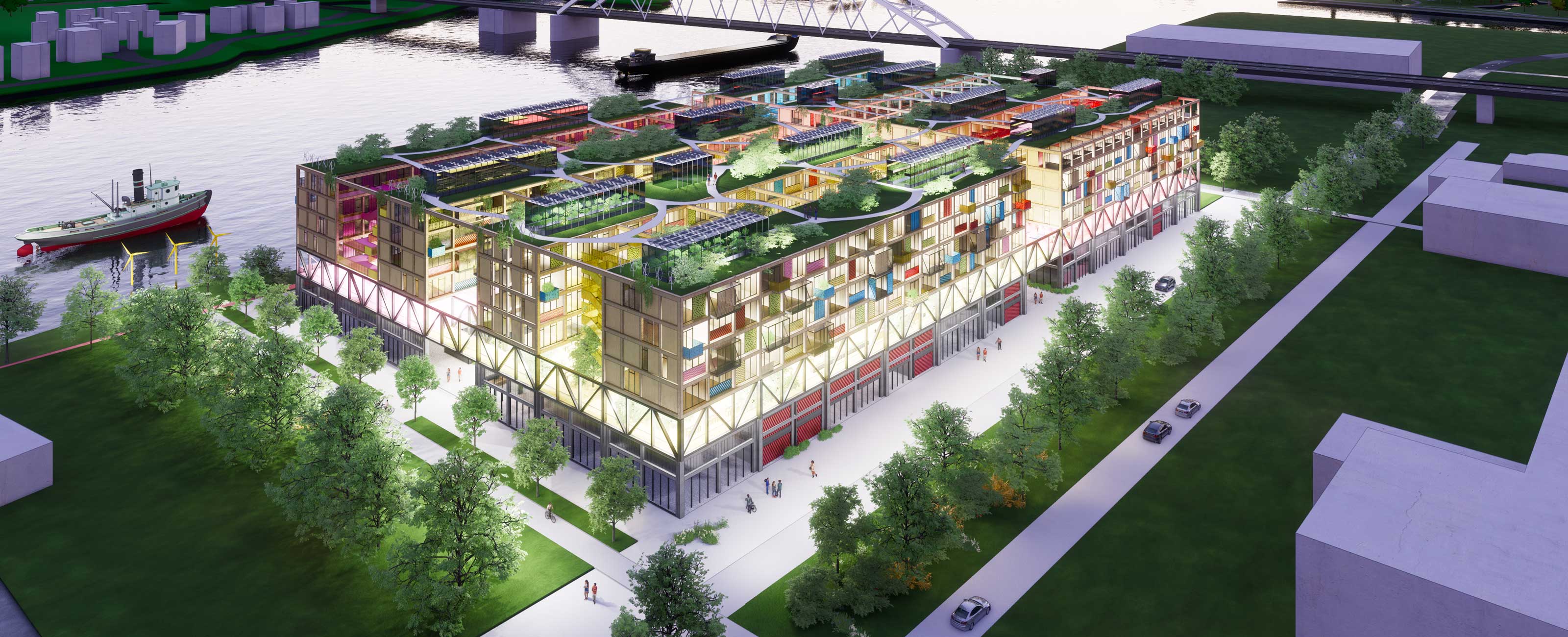
Higher Grounds - IABR, Dordrecht
Residents of this sustainable micro-city create their own dynamic biotope together in a building that offers permanent acute care in times of need
Self-supporting micro-city combines all functions for living together in a healthy way in pleasant and sustainable surroundings
We will have to deal with calamities such as natural disasters and pandemics in the future. Cities must anticipate these on time.
De Staart is located between the Wantij and Beneden Merwede waterways in Dordrecht. Unused up to now, this site makes for a suitable place of refuge in a flood emergency because it is situated on higher ground. The site offers an excellent opportunity to realize a sustainable and socially inclusive community. The fitting answer from EGM is called Higher Grounds: a multi-functional and highly sustainable building.
A place to truly live together
Higher Grounds is designed as a self-sufficient micro-city based on the idea of a community where solidarity and responsibility play a key role. Living, working, growing crops, learning, trading and relaxing all acquire a logical place in this dynamic micro-city.
Sustainable community
De Staart features a mixture of living and working. With small and innovative businesses in the manufacturing sector, Higher Grounds blends seamlessly with the dynamism and vibrancy of the surroundings. The inviting ground floor facilitates easy contact between entrepreneurs and local residents. Modular Cross Laminated Timber (CLT) construction makes it easy to increase or decrease the size of business and residential units. It also results in attractive rent prices.
Healthy and safe building
Located on four levels above the start-ups are the apartments. Residents themselves determine the size and layout of their apartment by adapting and combining the basic units. The apartments can therefore accommodate all living needs: from single students and self-employed individuals to families that want a spacious loft.
One floor is left open across the full width of the building between the ground floor and the apartments. Like at ground level in the neighbourhood, this open space can accommodate various public and shared activities. The heart of the micro-city provides a setting for convivial conversations among neighbours, encounters with local residents, children playing games, a market selling fresh produce, and plenty of space to accommodate thousands of evacuees in the event of flooding or other emergencies.
The green roof on top is fully utilized for relaxation and ‘urban farming’. On the rooftop farm, residents can cultivate vegetables for the community, small wind turbines generate some of the required energy, and circular waste processing takes place.
Flexible in times of need
Higher Grounds helps residents to achieve ambitious sustainability targets. At the same time, the building can effortlessly adapt in response to an unexpected natural disaster. In the case of an emergency, the public first floor can house up to 5,000 people. The building is fitted with all the necessary facilities for temporary additional accommodation and thus fulfils an important role in the community.
As part of the documentary series 'Bouwen onder NAP - beneden alle peil', The Fixers, a research programme made by the Cobouw media company, came along to learn more about Higher Grounds.
Energy neutral, even energy producing
The impact of climate change, evident in rising temperatures and water levels, calls for a response that goes beyond the minimal requirements for clean and sustainable energy. Higher Grounds sets a new standard in this regard. The building makes use of aqua-thermal energy, especially from surface water (TES), solar energy and wind energy, grey water for irrigating vegetation and the roof garden, and it reuses CO2 emissions. The building is even energy positive and therefore capable of producing enough energy not only to meet its own demands but also to supply affordable and clean energy for its surroundings.
Modular and circular building
Higher Grounds is an inclusive environment with a rich mixture of occupants, a development where start-ups can find affordable space. It is therefore essential to keep construction and user costs low, which is why the choice for sustainably prefabricated CLT units is so logical. Every unit has the same dimensions and is interchangeable, guaranteeing maximum flexibility. Residents can therefore adapt the size, layout and appearance of the apartment to suit their wishes. That makes it possible to customize a home for everybody.
An integral aspect of the design is the circular use of materials and building components. The residents of apartments can compose their own facade and interior themselves, possibly using materials taken from nearby buildings set for demolition. The ground floor is also constructed using harvested materials. The necessary steel comes from a nearby industrial shed that has been dismantled. In this way, Higher Grounds is socially and economically appealing to all parties.
Internationale Architecture Biennale Rotterdam – IABR
Higher Grounds is EGM’s answer to design research within IABR – Atelier Dordrecht. Together with the municipality of Dordrecht, and under the stewardship of Adriaan Geuze (West 8), four offices carried out research into water safety and urban development in Dordrecht. The research findings were presented within IABR and exhibited in a closing exhibition. EGM shared Higher Grounds with the public through publications, a mini-symposium and an informational video. We hope to actually construct Higher Grounds.
Images of IABR exhibition: Aad Hoogendoorn







